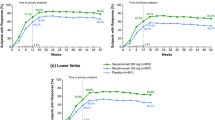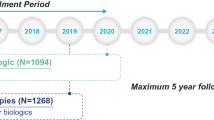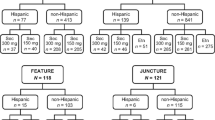Abstract
Background
The impact of psoriasis, response to treatment, and patients’ perceptions of treatment satisfaction vary by body area.
Objectives
We aimed to evaluate the level of response in lower limbs versus other body regions in patient with moderate to severe psoriasis treated with secukinumab and ustekinumab.
Methods
Data were pooled from CLEAR and CLARITY trials, which included patients with moderate to severe plaque psoriasis (Psoriasis Area and Severity Index [PASI] score of ≥ 12) aged ≥ 18 years and a diagnosis of ≥ 6 months before randomisation. Patients received either secukinumab 300 mg or ustekinumab 45/90 mg. The PASI 100 responders and mean PASI scores at weeks 4, 12, 16, 28, 40 and 52 in the head and neck, trunk, upper limbs and lower limbs were measured.
Results
At baseline, analysis of PASI scores for each body region revealed that the lower limbs were the most severely affected body region in both treatment arms (mean PASI scores: secukinumab 24.0; ustekinumab 24.4). For both drugs, the highest clearance rates at week 52 were achieved in the trunk (secukinumab 85.2% vs ustekinumab 68.7%) and head and neck (80.7% vs 68.9%), followed by the upper limbs (72.6% vs 61.9%) and lower limbs (68.1% vs 57.2%). At week 52, the mean PASI score was higher in the lower limbs in both treatment arms versus other body regions.
Conclusions
Lower limbs were the most severely affected and most difficult-to-treat regions in patients with psoriasis. Consistent with the individual results of both studies, secukinumab demonstrated numerically faster and higher skin clearance than ustekinumab in all body regions.
Clinical Trial Registration
CLEAR: NCT02074982; CLARITY: NCT02826603.





Similar content being viewed by others
References
Griffiths CEM, Barker JNWN. Pathogenesis and clinical features of psoriasis. Lancet. 2007;370:263–71.
Blauvelt A, Muram TM, See K, Mallinckrodt CH, Crowley JJ, van de Kerkhof P. Improvements in psoriasis within different body regions vary over time following treatment with ixekizumab. J Dermatol Treat. 2018;29:220–9.
Menter A, Cather JC, Jarratt M, Meng X, Guana A, Nyirady J. Efficacy of secukinumab on moderate to severe plaque psoriasis affecting different body regions: a pooled analysis of four phase 3 studies. Dermatol Ther (Heidelb). 2016;6:639–47.
Bagel J, Nia J, Hashim PW, Patekar M, de Vera A, Hugot S, et al. Secukinumab is superior to ustekinumab in clearing skin in patients with moderate to severe plaque psoriasis (16-week CLARITY results). Dermatol Ther (Heidelb). 2018;8:571–9.
Blauvelt A, Papp KA, Griffiths CEM, Randazzo B, Wasfi Y, Shen Y-K, et al. Efficacy and safety of guselkumab, an anti-interleukin-23 monoclonal antibody, compared with adalimumab for the continuous treatment of patients with moderate to severe psoriasis: results from the phase III, double-blinded, placebo- and active comparator-controlled VOYAGE 1 trial. J Am Acad Dermatol. 2017;76:405–17.
Blauvelt A, Prinz JC, Gottlieb AB, Kingo K, Sofen H, Ruer-Mulard M, et al. Secukinumab administration by pre-filled syringe: efficacy, safety and usability results from a randomized controlled trial in psoriasis (FEATURE). Br J Dermatol. 2015;172:484–93.
Blauvelt A, Reich K, Tsai TF, Tyring S, Vanaclocha F, Kingo K, et al. Secukinumab is superior to ustekinumab in clearing skin of subjects with moderate to severe plaque psoriasis up to 1 year: results from the CLEAR study. J Am Acad Dermatol. 2017;76:60-9.e9.
Gordon KB, Blauvelt A, Papp KA, Langley RG, Luger T, Ohtsuki M, et al. Phase 3 trials of ixekizumab in moderate to severe plaque psoriasis. N Engl J Med. 2016;375:345–56.
Langley RG, Elewski BE, Lebwohl M, Reich K, Griffiths CE, Papp K, et al. Secukinumab in plaque psoriasis: results of two phase 3 trials. N Engl J Med. 2014;371:326–38.
Lebwohl M, Strober B, Menter A, Gordon K, Weglowska J, Puig L, et al. Phase 3 studies comparing brodalumab with ustekinumab in psoriasis. N Engl J Med. 2015;373:1318–28.
Lee MG, Huang YH, Lee JH, Lee SC, Kim TG, Aw DC, et al. Secukinumab demonstrates superior efficacy and a faster response in clearing skin in Asian subjects with moderate to severe plaque psoriasis compared with ustekinumab: subgroup analysis from the CLEAR study. J Dermatol. 2019;46:752–8.
Thaçi D, Blauvelt A, Reich K, Tsai TF, Vanaclocha F, Kingo K, et al. Secukinumab is superior to ustekinumab in clearing skin of subjects with moderate to severe plaque psoriasis: CLEAR, a randomized controlled trial. J Am Acad Dermatol. 2015;73:400–9.
Ryan C, Korman NJ, Gelfand JM, Lim HW, Elmets CA, Feldman SR, et al. Research gaps in psoriasis: opportunities for future studies. J Am Acad Dermatol. 2014;70:146–67.
European Medicines Agency (EMA) Committee for Medicinal Products for Human Use (CHMP). Guideline on clinical investigation of medicinal products indicated for the treatment of psoriasis. http://www.ema.europa.eu/docs/en_GB/document_library/Scientific_guideline/2009/09/WC500003329.pdf. Accessed 10 Jun 2021.
Strober B, Papp KA, Lebwohl M, Reich K, Paul C, Blauvelt A, et al. Clinical meaningfulness of complete skin clearance in psoriasis. J Am Acad Dermatol. 2016;75:77-82.e7.
Lebwohl MG, Bachelez H, Barker J, Girolomoni G, Kavanaugh A, Langley RG, et al. Patient perspectives in the management of psoriasis: results from the population-based Multinational Assessment of Psoriasis and Psoriatic Arthritis Survey. J Am Acad Dermatol. 2014;70(871–81):e1-30.
Fredriksson T, Pettersson U. Severe psoriasis: oral therapy with a new retinoid. Dermatologica. 1978;157:238–44.
Armstrong AW, Vender R, Kircik L. Secukinumab in the treatment of palmoplantar, nail, scalp, and pustular psoriasis. J Clin Aesthet Dermatol. 2016;9:S12–6.
Baeten D, Sieper J, Braun J, Baraliakos X, Dougados M, Emery P, et al. Secukinumab, an interleukin-17A inhibitor, in ankylosing spondylitis. N Engl J Med. 2015;373:2534–48.
Deodhar A, Mease PJ, McInnes IB, Baraliakos X, Reich K, Blauvelt A, et al. Long-term safety of secukinumab in patients with moderate to severe plaque psoriasis, psoriatic arthritis, and ankylosing spondylitis: integrated pooled clinical trial and post-marketing surveillance data. Arthritis Res Ther. 2019;21:111.
Reich K, Warren RB, Coates LC, Di Comite G. Long-term efficacy and safety of secukinumab in the treatment of the multiple manifestations of psoriatic disease. J Eur Acad Dermatol Venereol. 2020;34(6):1161–73.
Deodhar A, Blanco R, Dokoupilová E, Hall S, Kameda H, Kivitz AJ, et al. Improvement of signs and symptoms of nonradiographic axial spondyloarthritis in patients treated with secukinumab: primary results of a randomized, placebo-controlled phase III study. Arthritis Rheumatol. 2021;73:110–20.
Newcombe RG. Two-sided confidence intervals for the single proportion: comparison of seven methods. Stat Med. 1998;17:857–72.
Kaushik SB, Lebwohl MG. Psoriasis: which therapy for which patient: psoriasis comorbidities and preferred systemic agents. J Am Acad Dermatol. 2019;80:27–40.
Kaushik SB, Lebwohl MG. Psoriasis: which therapy for which patient. Focus on special populations and chronic infections. J Am Acad Dermatol. 2019;80(1):43–53.
Griffiths CE, Sterry W, Brock F, Dilleen M, Stefanidis D, Germain JM, et al. Pattern of response in patients with moderate to severe psoriasis treated with etanercept. Br J Dermatol. 2015;172:230–8.
Navarini AA, Poulin Y, Menter A, Gu Y, Teixeira HD. Analysis of body regions and components of PASI scores during adalimumab or methotrexate treatment for patients with moderate to severe psoriasis. J Drugs Dermatol. 2014;13:554–62.
Sojević Timotijević Z, Majcan P, Trajković G, Relić M, Novaković T, Mirković M, et al. The impact of changes in Psoriasis Area and Severity Index by body region on quality of life in patients with psoriasis. Acta Dermatovenerol Croat. 2017;25:215–22.
Acknowledgements
The medical writing support was provided by Avinash Thakur and Shilpa Kakkar (Novartis Healthcare Pvt. Ltd, Hyderabad, India), which was funded by Novartis Pharma AG, in accordance with Good Publication Practice guidelines.
Author information
Authors and Affiliations
Corresponding author
Ethics declarations
Funding
This study was funded by Novartis Pharma AG. The funder had a role in the design and conduct of the study; collection, management, analysis, and interpretation of the data; preparation, review, or approval of the manuscript; and decision to submit the manuscript for publication.
Conflict of interest
Miguel Alpalhão collaborated with the pharmaceutical industry as a speaker for Almirall, Janssen, Leo and Sanofi, a scientific consultant for AbbVie and Novartis, and has participated as an investigator in multicentric clinical trials with AbbVie, Eli-Lilly, Leo and Novartis. Rita Diogo, Marc Vandemeulebroecke, Christine-Elke Ortmann and Torben Kasparek are employees of Novartis. Joana Duarte was an employee of Novartis during study conduct and until manuscript development. Paulo Filipe has collaborated with the pharmaceutical industry as a speaker, scientific consultant and investigator in multicentric clinical trials with AbbVie, Almirall, Boehringer-Ingelheim, Eli-Lilly, Janssen, Leo, Merck-Sharp-Dohme (MSD), Novartis, Pfizer and Sanofi.
Ethics approval
This study was conducted in accordance with Good Clinical Practice guidelines and the Declaration of Helsinki. The protocols were approved by the relevant institutional review board or ethics committee at each study site.
Consent to participate
Written informed consent was obtained from all individual participants included in both studies.
Consent to publish
Not applicable.
Code availability
Not applicable.
Availability of data and material
The datasets generated and/or analysed during the current study are not publicly available. Novartis is committed to sharing with qualified external researchers access to patient-level data and supporting clinical documents from eligible studies. These requests are reviewed and approved based on scientific merit. All data provided are anonymised to respect the privacy of patients who have participated in the trial in line with applicable laws and regulations. The data may be requested from the corresponding author.
Authors’ contributions
All authors contributed to the study conception and design. Material preparation, data collection and analysis were performed by TK, JD, RD, C-EO and MV. All authors contributed to drafting and critical appraisal of the manuscript and approved the final version for submission.
Meeting presentations
This study was presented in part at 29th European Academy of Dermatology and Venereology, Virtual Congress, 29–31 October, 2020.
Supplementary Information
Below is the link to the electronic supplementary material.
Rights and permissions
Springer Nature or its licensor holds exclusive rights to this article under a publishing agreement with the author(s) or other rightsholder(s); author self-archiving of the accepted manuscript version of this article is solely governed by the terms of such publishing agreement and applicable law.
About this article
Cite this article
Alpalhão, M., Duarte, J., Diogo, R. et al. Lower Limbs are the Most Difficult-to-Treat Body Region of Patients with Psoriasis: Pooled Analysis of CLEAR and CLARITY Studies of Secukinumab Versus Ustekinumab by Body Region. BioDrugs 36, 781–789 (2022). https://doi.org/10.1007/s40259-022-00558-2
Accepted:
Published:
Issue Date:
DOI: https://doi.org/10.1007/s40259-022-00558-2




